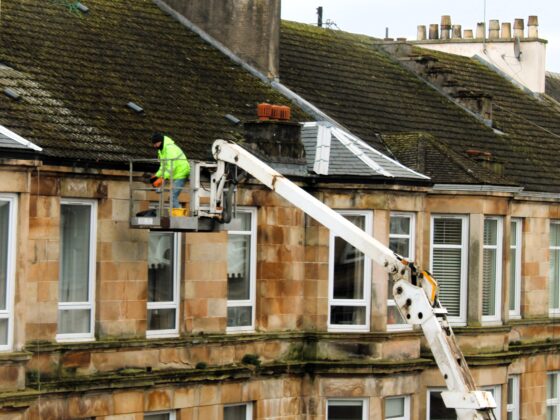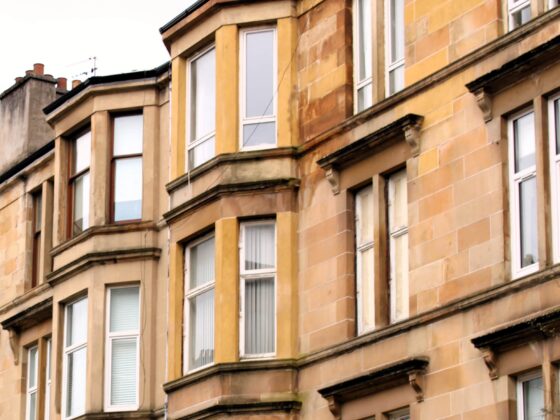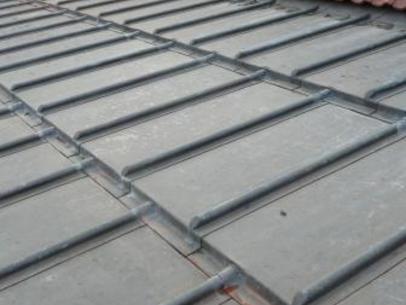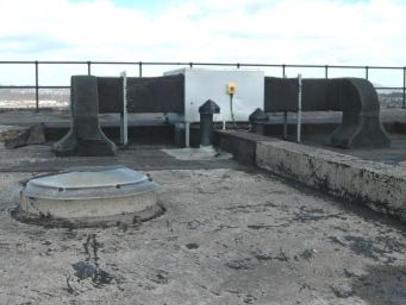Timber kit buildings, built mainly after 1980, can be clad in many materials.
Timber kit buildings have the advantage that the frames can be made off site in the dry, and then quickly erected. The thickness of the timber kit walls provides space for insulation which can save more energy. A timber frame supports the structure of the building.
The external skin of a timber frame building can be made out of a range of materials:
- brick
- brick and render
- render over cladding board
- zinc
- timber
- resin impregnated cladding boards
 Brick effect cladding. Such cladding may pose a fire risk, in taller buildings if not properly fixed with adequate fire stopping.
Brick effect cladding. Such cladding may pose a fire risk, in taller buildings if not properly fixed with adequate fire stopping.
The cavity within the wall needs to be vented to allow moisture to drain and to ventilate the timber. An internal vapour barrier stops moist air from inside your flat forming condensation within the timber kit. Breathable materials can also be used, which allow vapour transfer through the kit to prevent condensation within timber frame.
Some cladding board materials will expand and contract with temperature changes, and allowances for this should be made when fixing.
 Cladding board. Modern products can need repair as much as older ones. These products can also pose a fire risk, if not fixed with adequate fire stopping.
Cladding board. Modern products can need repair as much as older ones. These products can also pose a fire risk, if not fixed with adequate fire stopping.
With timber frame construction the whole structural frame and the separating floors are made from timber. However, the common stairwell is usually made with concrete floors and brick or block walls for fire protection.
 Timber cladding. Timber cladding is environmentally friendly and generally only used on lower rise buildings. If applied to buildings over four storeys in height, it may pose a fire risk, if not properly fire stopped.
Timber cladding. Timber cladding is environmentally friendly and generally only used on lower rise buildings. If applied to buildings over four storeys in height, it may pose a fire risk, if not properly fire stopped.
Fire risk and cladding
Some types of cladding and the way it is fixed has caused concern about fire risk. This is a particular concern in buildings over four storeys in height.
How to tell if your building is timber framed
Look for vent holes in the walls above windows, and above and below floors.
Modern blocks of flats over four storeys in height will probably be steel framed with concrete floors.
 Vents in timber kit building. Shown here in brick cladding, similar vents can be seen in rendered walls.
Vents in timber kit building. Shown here in brick cladding, similar vents can be seen in rendered walls.
Structural problems
Check for any cracking across brickwork, or movement in the brickwork, such as the cills kicking up. This can suggest excessive shrinkage of the kit. This can become a problem in two, three, and four-storey buildings. As the kit drops down, it then pushes up the cills. This effect is more likely to be noticed at the top floor of four-storey tenements as this is where the greatest effect of the shrinkage will be seen. An engineer may be needed to advise on any remedial work, even if the movement is not significant in structural terms.
Cracks may also appear at the top of flat entrance door frames inside the close because the close stair walls are built in brick or concrete and don’t shrink like the timber kit.
Distorted or cracked cladding boards can occur if the design has insufficient allowance for thermal movement.
 Timber kit shrinkage. The inner timber frame on which the cill rests has shrunk, causing the cill to drop inwards.
Timber kit shrinkage. The inner timber frame on which the cill rests has shrunk, causing the cill to drop inwards.
Damp related problems
If there are localised damp areas inside, is mould developing or is it a wet patch?
- if damp, the cavity may be breached or a damp-proof course may be defective
- if mould is present, it may be that the wall is cold because there is a lack of insulation or a ‘cold bridge’ has been formed by solid timbers or mortar fallen into the cavities
Ensure that ground levels are not allowed to be built up, so that they cover the damp-proof course.
Timber or board cladding may have been fixed to timber battens fitted to the frame. The gaps between the battens must be kept ventilated to prevent damp building up.
One common damp problem in timber kit construction occurs where a bay or part of the building juts out. To achieve this, a steel beam may be placed in the roof. Whilst the roof space should be ventilated, sometimes the steel beam is not insulated. It provides a cold surface which allows water vapour to condense and drip down onto the ceiling below. It often appears as if it is penetrating dampness. It can be remedied by adding insulation over the beam and ensuring there is a good vapour barrier throughout the ceiling.
Insulation problems
Older timber frame buildings were sometimes built with shallower timber frames leaving less room for insulation.
Quilt insulation that is hung within the timber frame is usually contained in netting. The insulation can slump or the builder may not have taken care in fixing the mineral wool properly. This defect is hard to spot, except when using an infrared camera.
Noise problems in timber kit separating walls
Timber frame separating walls do not have the same mass as brick or concrete walls, so it is important that the walls are isolated from one another. This is more of a problem in pre-1980s timber frame buildings.
The diagram below shows the range of different party wall construction build ups. The simplest has a mineral wool quilt suspended between the existing buildings. A more effective sound proofing design is one where both walls have a mineral wool lining, plus an inner sheathing board. The timber frame is covered in two layers of plasterboard for fire protection. The plasterboard joints of each layer should be offset, so they don’t coincide with the second layer (stagger bonded).
 Simple timber kit wall construction. Insulation quilt to one side of wall only: stagger joint plasterboard.
Simple timber kit wall construction. Insulation quilt to one side of wall only: stagger joint plasterboard.
 Modern timber kit party wall. Insulation quilt to both sides: inner timber sheathings and stagger joint plasterboard.
Modern timber kit party wall. Insulation quilt to both sides: inner timber sheathings and stagger joint plasterboard.
If electrical sockets or services are cut into the separating wall, then sound pathways may be created. A better design would have a ‘service zone’, consisting of an additional layer of plasterboard on battens to accommodate electrical wiring.
Other construction problems which can lead to noise penetration:
- sometimes the two parts of the cavity are built too close together
- slumped or missing insulation
- plasterboard sheets used in the wall lining may not have been stagger jointed, so there is no overlap and gaps are created which allow noise through
Noise solutions in timber kit separating walls
Get a specialist acoustic survey before deciding on a solution. The following options may be considered depending on the frequency of noise transmission:
- if the cavity wall is sheathed with a timber panel on the cavity side, then a blown fibre insulation can be injected into the voids between the timber studs in the frame (each leaf of the separating wall has to be sheathed, otherwise the blown fibre will fill the cavity and thus make contact with the other wall, allowing sound to travel across)
- a metal frame and channel can be fixed to the wall, a 50mm insulating quilt added between the frames, then covered with two layers of plasterboard
- an independent wall lining can be built 20mm from the existing party wall, connected only at the floor and ceiling
Professional help recommended?
Get professional help if you detect cills dropping inwards.
Further information




